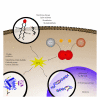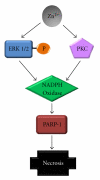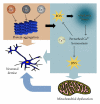Oxidative stress in neurodegenerative diseases: mechanisms and therapeutic perspectives
- PMID: 22191013
- PMCID: PMC3236428
- DOI: 10.1155/2011/467180
Oxidative stress in neurodegenerative diseases: mechanisms and therapeutic perspectives
Abstract
The incidence and prevalence of neurodegenerative diseases (ND) increase with life expectancy. This paper reviews the role of oxidative stress (OS) in ND and pharmacological attempts to fight against reactive oxygen species (ROS)-induced neurodegeneration. Several mechanisms involved in ROS generation in neurodegeneration have been proposed. Recent articles about molecular pathways involved in ROS generation were reviewed. The progress in the development of neuroprotective therapies has been hampered because it is difficult to define targets for treatment and determine what should be considered as neuroprotective. Therefore, the attention was focused on researches about pharmacological targets that could protect neurons against OS. Since it is necessary to look for genes as the ultimate controllers of all biological processes, this paper also tried to identify gerontogenes involved in OS and neurodegeneration. Since neurons depend on glial cells to survive, recent articles about the functioning of these cells in aging and ND were also reviewed. Finally, clinical trials testing potential neuroprotective agents were critically reviewed. Although several potential drugs have been screened in in vitro and in vivo models of ND, these results were not translated in benefit of patients, and disappointing results were obtained in the majority of clinical trials.
Figures





References
-
- García-Armesto S, Abadía-Tairax MB, Durán A, Hernández-Quevedo C, Bernal-Delgado E. Spain: health system review. Health Systems in Transition. 2010;12:1–295. - PubMed
-
- von Arnim CAF, Gola U, Biesalski HK. More than the sum of its parts? Nutrition in Alzheimer’s disease. Nutrition. 2010;26(7-8):694–700. - PubMed
-
- El-Bachá RS, De-Lima-Filho JL, Guedes RCA. Dietary antioxidant deficiency facilitates cortical spreading depression induced by photoactivated riboflavin. Nutritional Neuroscience. 1998;1(3):205–212. - PubMed
-
- Mandel S, Grünblatt E, Riederer P, Gerlach M, Levites Y, Youdim MBH. Neuroprotective strategies in Parkinson’s disease: an update on progress. CNS Drugs. 2003;17(10):729–762. - PubMed
Publication types
MeSH terms
Substances
LinkOut - more resources
Full Text Sources
Medical

